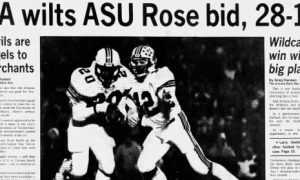FOLLOW @JAVIERJMORALES ON TWITTER!
[rps-paypal]
[ezcol_1half id=”” class=”” style=””]

TABLE OF CONTENTS:
— General history
— J.F. “Pop” McKale
— The games
— Comparisons then and now
— Wildcats nickname
— Military service
— Rankings
— The players
[/ezcol_1half]
[ezcol_1half_end id=”” class=”” style=””]
Clipping of actual L.A. Times article published Nov. 8, 1914
Excerpt from L.A. Times, Nov. 8, 1914, authored by Bill Henry:
“Arizona’s cactus-fed athletes, despite heroic efforts on the part of their two halfbacks, (Asa) Porter and (Franklin) Luis, went down to defeat before the Occidental Tigers yesterday afternoon, the tally with all precincts heard from being 14 to 0 in favor of the Tigers.
Confident of rolling up a big score, the Tigers took the field with grins on their faces, but before the game was 10 seconds old they knew they had a battle on their hands.
The Arizona men showed the fight of wild cats and displayed before the public gaze a couple of little shrimps in the backfield who defied all attempts of the Tigers to stop them.”This site will conduct a countdown in a 100-day period, leading up to Arizona’s 2014 football season-opener with UNLV on Aug. 29 at Arizona Stadium. The 100 Days ‘Til Kickoff countdown will include information daily about the historic 1914 Arizona team that helped create the school’s nickname of “Wildcats” because of how they played that fateful day against Occidental.
[/ezcol_1half_end]
[ezcol_1half id=”” class=”” style=””]
In the next few days, the series will provide multiple quick facts of each player. Today’s player is:

Harry Ellsworth Turvey went on to captain the Arizona football team and serve as student body president in 1916-17
Harry Ellsworth Turvey (1895-1942)
Sophomore fullback from Blackwell, Oklahoma
Turvey attended Douglas High School (Class of 1913) and was a standout football player there before going to Arizona. He earned a scholarship of $150 after taking an examination before the county superintendent of schools in Tombstone. Each county in the state awarded two scholarships to Arizona honoring the infancy of its statehood (1912).
When Turvey filled out his draft registration card for World War I in 1917, he listed his residence as Douglas and that he was working for himself as a farmer. Before that, during his senior season of 1916 of which he was captain of the football team and student body president, he was active in Arizona’s cadet battalion.
[/ezcol_1half]
[ezcol_1half_end id=”” class=”” style=””]
THE LAST WEEK IN THE SERIES:
— No. 36: Orville “Speedy” McPherson, fullback
— No. 37: Turner Church Smith, left guard
— No. 38: Ernest James Renaud, fullback
— No. 39: Franklin Luis, halfback
— No. 40: George Sweeney, right end
— No. 41: Emzy “Swede” Lynch, center
— No. 42: Verne La Tourette, left halfback
[/ezcol_1half_end]
He volunteered his services to train younger students to prepare them to do battle for their country. Turvey served in World War I with the U.S. Army, first deployed to Camp Funston in Kansas on Oct. 3, 1917.
Two years later, on Oct. 2, 1919, he married Gladys Rubina Schindler in Douglas. He passed away at only 46 from a heart attack in 1942 and was buried in his native Blackwell, Okla.
He had relocated to Blackwell from Douglas and started the Turvey Meat Packing Company that was in operation until 1972.

The 1914 Arizona football team that earned the honor of being named the first “Wildcats” was composed of (front row, left to right): Verne La Tourette, George Seeley, Leo Cloud, Richard Meyer, Asa Porter. Second row: Franklin Luis, Lawrence Jackson, Ray Miller, J.F. “Pop” McKale (coach), Turner Smith, Harry Hobson (manager), Orville McPherson, Albert Crawford, Ernest Renaud. Back row: Albert Condron, Emzy Lynch, Charley Beach, Vinton Hammels, Bill Hendry, George Clawson, Harry Turvey.
(AllSportsTucson.com graphic/Photo from University of Arizona Library Special Collections)
[ezcol_1half id=”” class=”” style=””]
What they were talking about on this day in 1914
Saturday, July 25, 1914
Diplomatic relations between Austria-Hungary and Serbia are formally broken off and war is regarded by the public as almost a certainty. The Serbian government calls Austria-Hungary’s ultimatum for an explanation of the assassination of Archduke Ferdinand and his wife “unsatisfactory”. The ultimatum passes and tension builds. Martial law is declared throughout the Austria-Hungary empire. World War I looks to be on the horizon.
[/ezcol_1half]
[ezcol_1half_end id=”” class=”” style=””]
[/ezcol_1half_end]
ALLSPORTSTUCSON.com publisher, writer and editor Javier Morales is a former Arizona Press Club award winner. He also writes articles for Bleacher Report and Lindy’s College Sports.






















